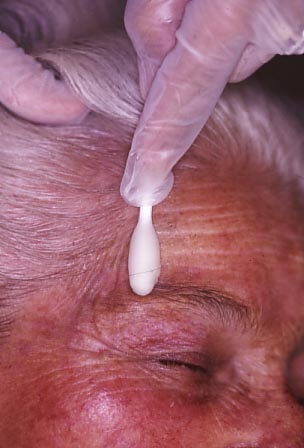Chemical Peel
(CHEMOEXFOLIATION)
Chemical peels have been used to beautify the skin since ancient times. Various naturally occurring substances such as lactic acid, citric acid or tartaric acid have been used for mild exfoliation . A youthful, even, smooth and spotless skin has always been considered the ideal of beauty. Chemical peels are typical dermatological treatment methods and have a wide range of applications. Although best known for their use in the aesthetic field, chemical peels are also used as a curative treatment for acne, keratoses, scars and hyperpigmentation . In-depth knowledge of the skin structure, consideration of the skin type, the choice of the right peeling substance, as well as good pre-treatment and phase-appropriate after-treatment of the skin are decisive for successful use with few side effects.
With chemical peeling, the application of acids to the skin leads to a therapeutic etching of the upper layers of the skin, which, depending on the strength of the peeling, is shed after a few days in the form of scaling or peeling.
Since the penetration depth of the peeling substance is decisive for the effect, the peelings are divided into superficial, medium-deep and deep peelings. In addition to the choice of acid, its concentration and type of application, it is also important to recognize the penetration depth of the treatment so as not to etch too deeply into the tissue.
How is the peeling done?
The peeling substance is either applied in layers with a soft brush or rubbed in with cotton swabs. Rubbing increases penetration. The depth of penetration can also be influenced by pretreating the skin with creams containing fruit acids or by applying other acids before the peeling.
During treatment, patients feel a tingling sensation or a more or less intense burning sensation. Anesthetic cream or a hand dryer make the treatment tolerable. In the case of superficial peelings, the acid is neutralized with sodium bicarbonate after a few minutes. In the case of medium-deep and deep peelings, the whitening of the skin (frosting) is awaited before the treatment ends. After the treatment, either an aloe vera gel or a soothing moisturizer is applied.
What are the reactions after the peeling?
In the case of superficial peelings, there is a fine desquamation of the epidermis a few days after the treatment, the patient remains socially acceptable. With medium-deep and deep peelings, coagulation necrosis of the epidermis and papillary dermis occurs, which is followed by extensive peeling of the skin. The patients are not socially acceptable for about 1 week. As long as the skin is still red, sun protection with SPF 50 is necessary. Otherwise, hyperpigmentation can occur.


What do superficial peels do?
The effect of superficial peelings is mainly in the area of the epidermis. A few days after the treatment, the upper epidermis (stratum corneum) exfoliates, which becomes noticeable as fine scaling. As a result, the corneal layer becomes thinner, and the skin gains shine and color. In addition, the increased epidermal cell turnover also causes changes in the dermis, such as cell renewal, collagen regeneration and better hydration.
What is treated with superficial peelings?
Acne vulgaris, hyperpigmentation of the skin (melasma), fine acne scars, fine wrinkles, and slight actinic damage to the skin. For superficial or light peelings, fruit acids such as alpha hydroxy acids (AHA) and beta hydroxy acids (e.g. salicylic acid) and lactic acid are primarily used.
What peeling substances are commonly used?
- Glycolic Acid (Sugar Cane Juice) - Glycolic acid
- Lactic Acid (from milk and tomatoes) - Lactic acid
- Pyruvic Acid (Grapes) - Pyruvic acid
- Citric Acid (Citrus) - Citric acid
- Salicylic Acid – Salicylic acid
- Retinoic Acid – Tretinoin peeling
- Jessner's solution
- Trichloroacetic Acid (TCA) 15%
How does a medium-deep peeling work?
Depending on the concentration of the acid, the penetration depth of the medium-deep peelings reaches into the superficial layers of the dermis. A few days after the treatment, the skin peels over a large area, which is completed after 5-7 days. The skin is then somewhat reddened and should be well protected from the UV light. The most commonly used peeling substance is 25% – 35% trichloroacetic acid (TCA). The inflammatory reactions stimulate the formation of new collagen type I in the dermis and thus the skin appears firmer. Pigment spots and other signs of aging can be effectively removed.
What are deep peels?
Solutions containing phenol are mainly used for deep peelings. The penetration depth is up to the middle dermis. Shedding of the epidermis and superficial dermis occurs, accompanied by a strong inflammatory reaction. Wound healing takes 8-14 days. The resulting wound healing processes have a very good regenerating effect on the skin. New collagen and elastic fibers are formed, resulting in an excellent tightening effect. The smoothing effect on wrinkles can be compared to that of a CO2 laser. Deep peeling is good for treating acne scars, severe actinic changes, and treating wrinkles and sagging skin. Although very effective, phenol peeling is not very popular because of its cardiotoxic and nephrotoxic properties. Phenol is absorbed percutaneously within 30 minutes and then eliminated via the liver and kidneys. Because of possible arrhythmias, treatment should always be carried out under ECG monitoring. Sedoanalgesia is often used because of severe pain.
What complications can occur after peeling?
The complication rate increases with increasing concentration and penetration depth of the peeling substance. Dyschromia (hypo- or hyperpigmentation) is most common in deeper skin layers , and wound healing disorders are rare. Stronger and prolonged redness can be the harbinger of hypertrophic scarring. Herpes simplex or bacterial infections immediately after treatment can lead to scarring. For this reason, antiviral and antibacterial prophylaxis is always carried out in the case of deeper peelings and a corresponding anamnesis.
Individual consultation
Individual consultation: We would be happy to consult you extensively on the individual examinations and treatment options in one of our offices. You are also welcome to schedule an appointment online.
